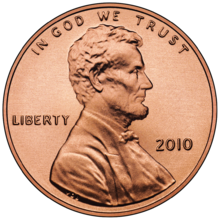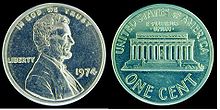
A 2010 American penny (Photo credit: Wikipedia)
What is a penny made of? While more accurately called the “one-cent piece”, the penny remains the most common term for the smallest denomination of coinage. The United States has started a discussion on the possibility of taking the penny out of circulation, following a move by the Canadian government to eliminate the penny, which officially took effect Feb 4, 2013.
The main argument for the possible extinction of the penny from North America is that the coin reportedly costs more to produce than each cent is worth. If that is the case, what are pennies made of exactly that makes them so costly to produce?
Through the Years
It turns out that the question of penny composition is not so simple. The various metals and their percentages within the coppery coin have changed drastically within the 154 year lifespan of the penny.
The original penny was minted in 1858 and based on a combination of British, American and Spanish coinage. They were not widely accepted into currency by the general public until near the end of the 19th century.
At its inception, the penny had a composition of 95% copper, 4% tin and 1% zinc. This combination gave it the shiny copper colour that most associate with the one cent piece. Eighteen years after the first minting, the numbers changed slightly to 95.5% copper, 3% tin and 1.5% zinc.
When the price of copper rose in 1920, the composition of the penny was not changed, but rather the size was altered to accommodate for rising costs.

The extremely rare 1974 aluminum penny that sits in the Smithsonian (Photo credit: Wikipedia)
In 1942, the amount of copper increased to 98% within the pennies, leaving tin at 0.5% and zinc at 1.5%. At one point in 1973, when the price of copper rose, the U.S. mint experimented with a completely different material. 1,579,324 pennies were produced out of Aluminum (dated 1974), and were made ready for public release. However, the aluminum pennies were eventually rejected for mainstream production.
While there were a number of reasons the aluminum penny never made it into circulation, one of more interesting reasons was that they wouldn’t appear on X-rays if they were accidentally swallowed (at least, according to rumor). The fabled aluminum penny is now illegal to own, though one still sits in the Smithsonian museum.
In 1978, the concentrations switch around to leave tin with a 1.75% share of the penny and zinc with 0.25%.
Modern Pennies
The continued rising cost of copper caused a significant change in composition beginning in 1997. The pennies switched from primarily copper to primarily zinc with a copper coating. The zinc took up 98.4% of the coin with the copper coating taking only 1.6%. This type of penny is still produced.
In the year 2000, another penny composition was introduced alongside the zinc based penny. These pennies were composed of 94% steel, 1.5% nickel and 4.5% copper plating.
Modern pennies are therefore made of either copper-plated steel or copper-plated zinc.
Goodbye Penny?
Due to rising metal costs and production costs, the Canadian Government axed the penny. The multiple transformations it underwent over the years to save money just weren’t enough to save it. According to the Royal Canadian Mint, this permanent death of the zinc and steel penny will save Canadians $11 million a year.
While many people find it confusing, the move is generally regarded as a good thing. Seeing the success of this move sparked a large discussion in the United States government to follow their northern neighbours’ footsteps. Whether or not it will actually happen remains to be seen, however.
Sources
- “A national symbol–the 1-cent coin”. Royal Canadian Mint. Retrieved 2013-02-21.
- “Phasing out the Penny”, Royal Canadian Mint. Retrieve 2013-02-21.